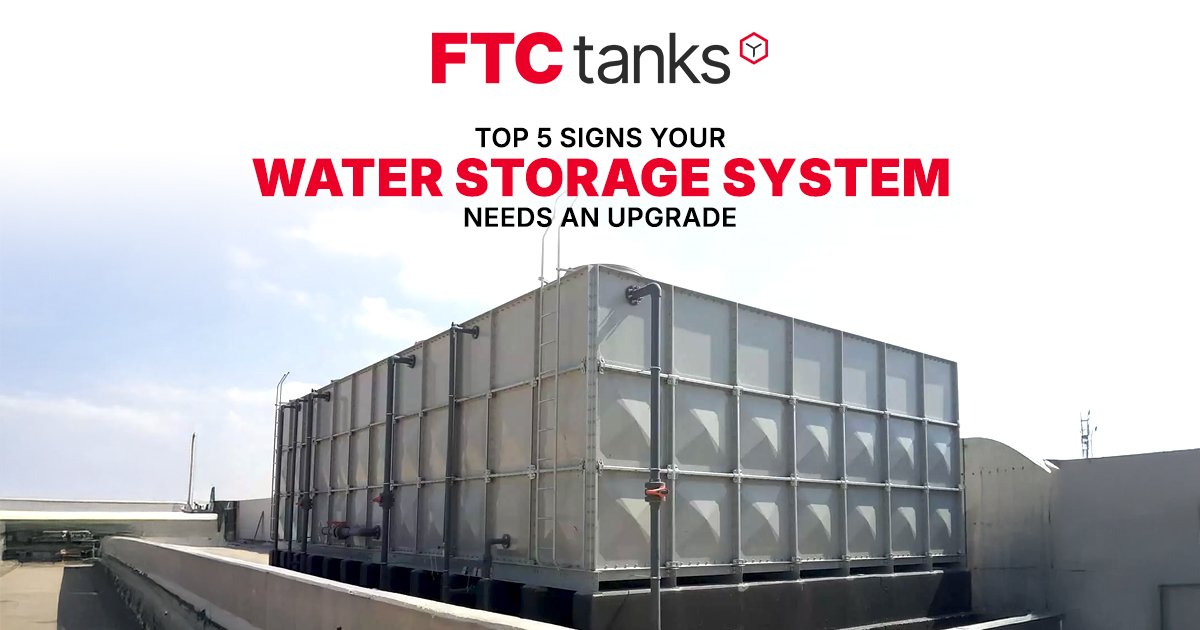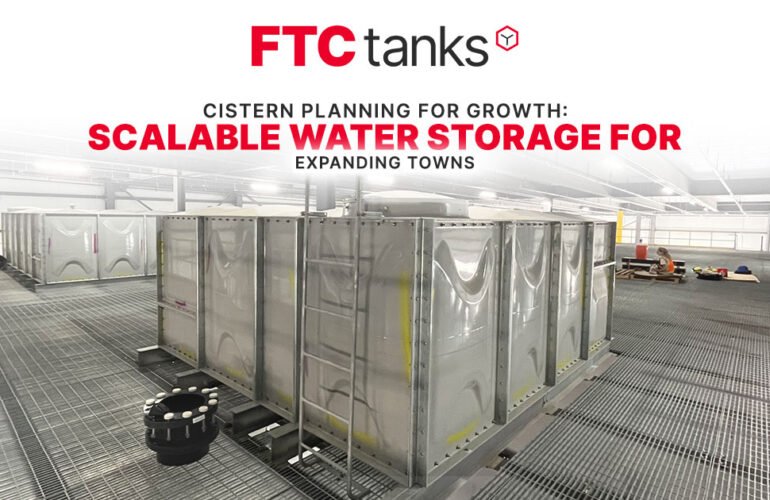Like most people, you don’t think about your water tank—until the water tastes weird, pressure drops, or a sudden leak shows up. By the time these things happen, your water storage system might already be failing.
Like any equipment, tanks wear out. Materials corrode. Seals loosen. Bacteria creeps in. And the scary part? You may not notice until your water turns brown or smells like old pipes.
A failing water tank isn’t just an inconvenience—it can affect health, damage equipment, and cost you more in wasted water and emergency repairs. That’s why it’s worth knowing when your system is past its prime.
Modern options like FRP water tanks are built to solve the very problems older systems create. If you’re seeing any of the signs below, it may be time to upgrade before the real trouble starts.
1. Your Water Looks Cloudy, Yellow, or Full of Sediment
Water should be clear. It shouldn’t look like it came from a rusted tap or a pond. If your water has started looking dirty—or if you see little particles floating in it—that’s a major warning sign.
This usually means the inside of your cistern is deteriorating. Rust flakes, scales, or algae can build up over time. Older metal tanks are especially prone to this, and once the protective layer breaks down, there’s nothing stopping corrosion from getting into your supply.
It’s not just gross—it’s unsafe. That murky water might contain bacteria or heavy metals, especially if the tank hasn’t been cleaned in years. Even concrete tanks can start breaking down, leaving behind fine sediment that finds its way into every faucet or irrigation line.
The solution? Tanks built for long-term performance—like FRP tanks. Their smooth, non-corrosive interiors don’t let buildup stick. If you go one step further with NSF certified water tanks, you get tested assurance that your water won’t just look better; it’ll be safer to use as well.
2. The Water Smells Weird or Tastes Even Worse
No one expects tap water to taste like a fancy spring, but it shouldn’t make you gag either. If you’re catching a whiff of something musty, metallic, or plastic-like—or if your water has a strange aftertaste—it’s time to take a serious look at what’s going on inside your water storage tanks.
Most people blame the pipes or the water source. But in many cases, the problem is sitting quietly in the backyard or behind the building: the cistern itself. Mold, algae, and stagnant water build up over time, especially in tanks that haven’t been cleaned or sealed properly. In older tanks, especially those made from low-quality plastics, chemical leaching is a common problem. That odd “pool toy” taste? That’s your tank breaking down from the inside.
Now, here’s where quality makes a difference. NSF certified water tanks built to protect your water’s purity. They’re made from materials tested for taste, odor, and long-term safety. FRP tanks (fiberglass-reinforced plastic) go a step further—they don’t leach, corrode, or absorb odors. Their surface doesn’t support microbial growth either.
If you’ve started using bottled water because your stored supply tastes funky, your tank is sending you a clear message: it’s time to upgrade.
3. You’re Seeing Cracks, Leaks, or Damp Spots Around the Tank
Leaks don’t always show up in a dramatic way. Sometimes it’s just a damp patch near the base or a slow drip that comes and goes. Easy to ignore—until it’s not. With water storage, a small leak is usually a sign of a much bigger issue waiting to happen.
Old steel cistern tends to rust from the inside out. Over the years, seams and bolts weaken, especially if the tank’s been exposed to the elements. With a concrete cistern, hairline cracks form as the ground shifts, or the structure expands and contracts. At first, you think a patch will buy you some time. But those fixes rarely hold up. Sooner or later, the damage spreads.
Now, let’s talk about modular FRP water tanks. Yes, they have seams—lots of them. But here’s the difference: it’s not the panels that fail, it’s the sealant that holds them together. And this is where the real secret lies.
We use an NSF-certified sealant that’s built to last. It stays flexible, resists cracking, and holds tight for up to 40 years. It’s the part most people overlook—but it’s what keeps these tanks watertight, decade after decade.
So, if you’re spotting leaks or chasing damp spots around an old tank, don’t just blame the structure. It might be time for a better system—and a sealant that’s built to last.
4. The Pressure’s Weak, and You Don’t Know Why
Low water pressure is one of those problems that creeps up on you. One day, everything went fine. The next, your lines sputter, or flow slows to a crawl. First thoughts? It must be the pump. But more often than people realize, it’s the water storage tanks that’s to blame.
Older tanks weren’t built with today’s systems in mind. Over time, sediment collects around the outlet or builds up inside the pipes. That buildup restricts flow, especially in tanks that haven’t been cleaned or inspected in years. Even a slightly misaligned valve or corroded fitting can throw things off.
It’s not just about irrigation or showers. If your tank feeds a fire sprinkler system, restricted pressure is a major safety risk. If sediment clogs the line, that system may not respond when you need it most. The same goes for any setup that relies on consistent, pressurized flow—commercial washdowns, backup water supplies, even HVAC cooling.
Upgrading to a modern FRP water tank gives you an edge. The smooth, non-corrosive interior helps prevent buildup. And because the tank is built with modern connections in mind, it integrates more reliably with everything downstream.
If weak pressure has become part of your routine, don’t just tweak the plumbing. The tank itself may be what’s holding everything back—and when lives or equipment depend on steady flow, that’s not a risk worth taking.
5. Outdated Materials or Missing Certification
If your tank has been around for decades, there’s a good chance it was built before today’s health and safety standards even existed. Materials that were acceptable years ago—like uncoated steel or low-grade plastic—may now be flagged as risks for contamination or failure.
That’s why NSF certified water tanks matter. These tanks go through strict independent testing to make sure they meet current codes for drinking water use. They’re built with safety in mind, from the resins used to the fittings installed.
FRP tanks, especially those with NSF certification, are designed for long-term use. They’re reliable, low-maintenance, and they don’t degrade like older materials do.
If your current tank lacks certification—or if you’re not even sure what it’s made of—it may be time to move on from guesswork and step up to something tested, trusted, and proven.
Bonus Tip: When in Doubt, Inspect and Replace
If you’re not sure whether your water tanks needs attention, start with a simple inspection. Look for cracks, corrosion, or signs of wear—especially if your system has been in place for years. Older tanks are more likely to fail suddenly, and routine checks can help you catch small issues before they become major problems.
Patching and temporary fixes only go so far. If you find yourself repairing the same leak or dealing with recurring pressure drops, it’s usually more cost-effective to upgrade. Switching to a FRP water tank give you better performance, longer lifespan, and peace of mind. And if you need a solution for a tight or complex setup, FTC Tanks also offers custom-built cistern designed for confined spaces and unique site requirements.
Don’t wait for the system to break down—get ahead of it with a reliable replacement.
Final Thoughts
Water that smells odd, flows weakly, or looks dirty isn’t just unpleasant—it’s a sign that your water storage system might be failing. Ignoring these problems can lead to water damage, health risks, or costly emergency repairs.
Upgrading to a modern solution like an NSF certified water tank is more than just a fix—it’s an investment in safe, consistent, and efficient water storage. Whether you’re replacing an aging cistern or planning for future growth, now is the time to take action.
FTC Tanks offers high-performance water storage tanks that meet the highest standards for durability, cleanliness, and design flexibility. Their team can help you choose the right fit, including custom options for specialized needs.
Don’t wait for failure—upgrade your water storage today with FTC Tanks.





